Project Report: Globalisation, Recruitment, Selection at Nestle
VerifiedAdded on 2020/11/12
|29
|6994
|302
Report
AI Summary
This report examines Nestle's project management strategies, focusing on recruitment, selection, and training within a globalized business environment. It begins by outlining project aims and objectives, specifically addressing how multinational companies like Nestle can improve these processes to achieve international goals. The report then details a comprehensive project management plan, covering essential elements such as cost estimation, scope definition, scheduling, quality control, communication strategies, risk assessment, and resource allocation. A work breakdown structure (WBS) and a Gantt chart are also developed to visualize project tasks and timelines. The research methodology section discusses both qualitative and quantitative research methods used to gather and analyze data. Findings and recommendations are communicated to improve recruitment, selection, and training practices. The report concludes with a reflection on the value of undertaking the research, providing insights into the impact of globalization on human resource management within Nestle and other multinational companies.

MANAGING A
SUCCESSFUL
BUSINESS PROJECT
SUCCESSFUL
BUSINESS PROJECT
Paraphrase This Document
Need a fresh take? Get an instant paraphrase of this document with our AI Paraphraser
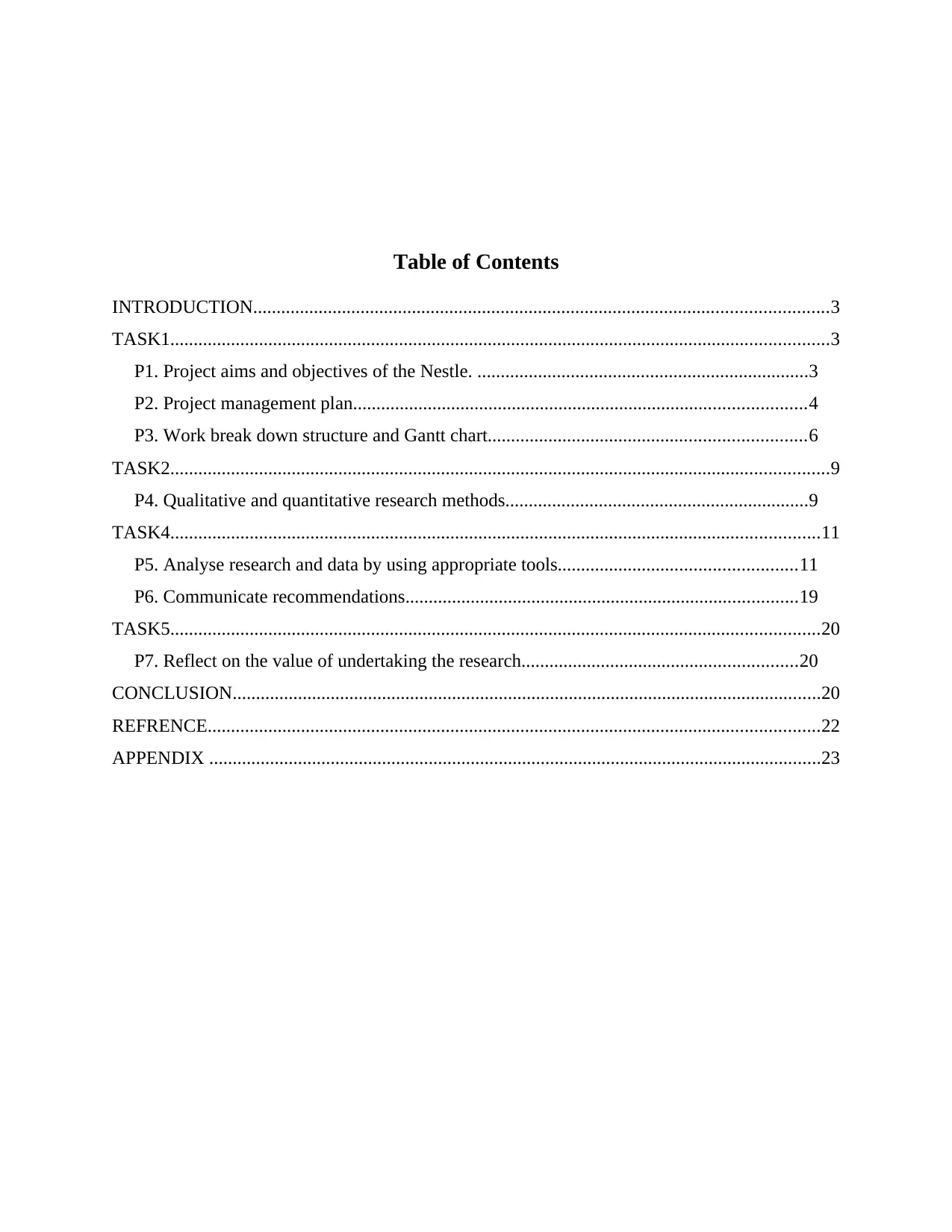
Table of Contents
INTRODUCTION...........................................................................................................................3
TASK1.............................................................................................................................................3
P1. Project aims and objectives of the Nestle. .......................................................................3
P2. Project management plan.................................................................................................4
P3. Work break down structure and Gantt chart....................................................................6
TASK2.............................................................................................................................................9
P4. Qualitative and quantitative research methods.................................................................9
TASK4...........................................................................................................................................11
P5. Analyse research and data by using appropriate tools...................................................11
P6. Communicate recommendations....................................................................................19
TASK5...........................................................................................................................................20
P7. Reflect on the value of undertaking the research...........................................................20
CONCLUSION..............................................................................................................................20
REFRENCE...................................................................................................................................22
APPENDIX ...................................................................................................................................23
INTRODUCTION...........................................................................................................................3
TASK1.............................................................................................................................................3
P1. Project aims and objectives of the Nestle. .......................................................................3
P2. Project management plan.................................................................................................4
P3. Work break down structure and Gantt chart....................................................................6
TASK2.............................................................................................................................................9
P4. Qualitative and quantitative research methods.................................................................9
TASK4...........................................................................................................................................11
P5. Analyse research and data by using appropriate tools...................................................11
P6. Communicate recommendations....................................................................................19
TASK5...........................................................................................................................................20
P7. Reflect on the value of undertaking the research...........................................................20
CONCLUSION..............................................................................................................................20
REFRENCE...................................................................................................................................22
APPENDIX ...................................................................................................................................23
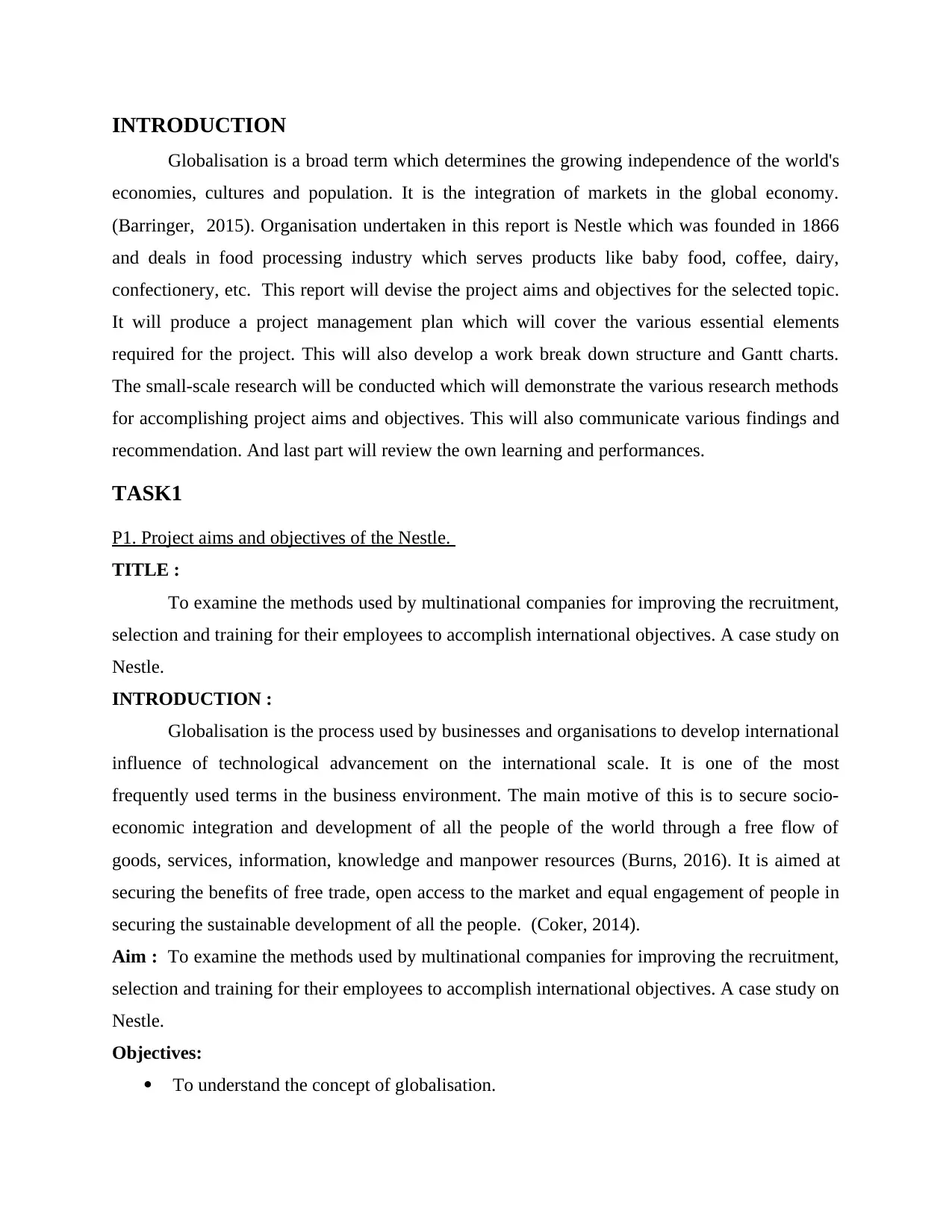
INTRODUCTION
Globalisation is a broad term which determines the growing independence of the world's
economies, cultures and population. It is the integration of markets in the global economy.
(Barringer, 2015). Organisation undertaken in this report is Nestle which was founded in 1866
and deals in food processing industry which serves products like baby food, coffee, dairy,
confectionery, etc. This report will devise the project aims and objectives for the selected topic.
It will produce a project management plan which will cover the various essential elements
required for the project. This will also develop a work break down structure and Gantt charts.
The small-scale research will be conducted which will demonstrate the various research methods
for accomplishing project aims and objectives. This will also communicate various findings and
recommendation. And last part will review the own learning and performances.
TASK1
P1. Project aims and objectives of the Nestle.
TITLE :
To examine the methods used by multinational companies for improving the recruitment,
selection and training for their employees to accomplish international objectives. A case study on
Nestle.
INTRODUCTION :
Globalisation is the process used by businesses and organisations to develop international
influence of technological advancement on the international scale. It is one of the most
frequently used terms in the business environment. The main motive of this is to secure socio-
economic integration and development of all the people of the world through a free flow of
goods, services, information, knowledge and manpower resources (Burns, 2016). It is aimed at
securing the benefits of free trade, open access to the market and equal engagement of people in
securing the sustainable development of all the people. (Coker, 2014).
Aim : To examine the methods used by multinational companies for improving the recruitment,
selection and training for their employees to accomplish international objectives. A case study on
Nestle.
Objectives:
To understand the concept of globalisation.
Globalisation is a broad term which determines the growing independence of the world's
economies, cultures and population. It is the integration of markets in the global economy.
(Barringer, 2015). Organisation undertaken in this report is Nestle which was founded in 1866
and deals in food processing industry which serves products like baby food, coffee, dairy,
confectionery, etc. This report will devise the project aims and objectives for the selected topic.
It will produce a project management plan which will cover the various essential elements
required for the project. This will also develop a work break down structure and Gantt charts.
The small-scale research will be conducted which will demonstrate the various research methods
for accomplishing project aims and objectives. This will also communicate various findings and
recommendation. And last part will review the own learning and performances.
TASK1
P1. Project aims and objectives of the Nestle.
TITLE :
To examine the methods used by multinational companies for improving the recruitment,
selection and training for their employees to accomplish international objectives. A case study on
Nestle.
INTRODUCTION :
Globalisation is the process used by businesses and organisations to develop international
influence of technological advancement on the international scale. It is one of the most
frequently used terms in the business environment. The main motive of this is to secure socio-
economic integration and development of all the people of the world through a free flow of
goods, services, information, knowledge and manpower resources (Burns, 2016). It is aimed at
securing the benefits of free trade, open access to the market and equal engagement of people in
securing the sustainable development of all the people. (Coker, 2014).
Aim : To examine the methods used by multinational companies for improving the recruitment,
selection and training for their employees to accomplish international objectives. A case study on
Nestle.
Objectives:
To understand the concept of globalisation.
⊘ This is a preview!⊘
Do you want full access?
Subscribe today to unlock all pages.

Trusted by 1+ million students worldwide
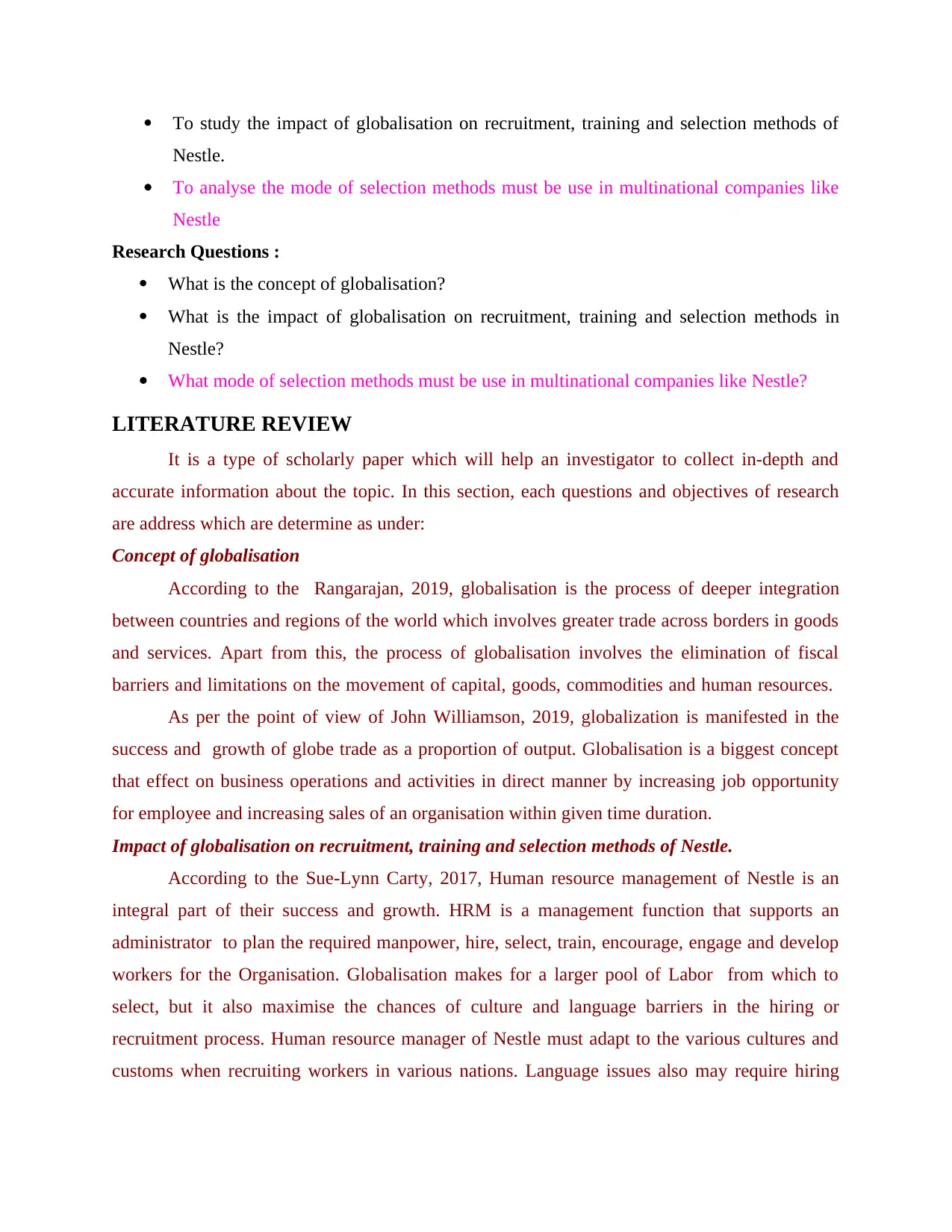
To study the impact of globalisation on recruitment, training and selection methods of
Nestle.
To analyse the mode of selection methods must be use in multinational companies like
Nestle
Research Questions :
What is the concept of globalisation?
What is the impact of globalisation on recruitment, training and selection methods in
Nestle?
What mode of selection methods must be use in multinational companies like Nestle?
LITERATURE REVIEW
It is a type of scholarly paper which will help an investigator to collect in-depth and
accurate information about the topic. In this section, each questions and objectives of research
are address which are determine as under:
Concept of globalisation
According to the Rangarajan, 2019, globalisation is the process of deeper integration
between countries and regions of the world which involves greater trade across borders in goods
and services. Apart from this, the process of globalisation involves the elimination of fiscal
barriers and limitations on the movement of capital, goods, commodities and human resources.
As per the point of view of John Williamson, 2019, globalization is manifested in the
success and growth of globe trade as a proportion of output. Globalisation is a biggest concept
that effect on business operations and activities in direct manner by increasing job opportunity
for employee and increasing sales of an organisation within given time duration.
Impact of globalisation on recruitment, training and selection methods of Nestle.
According to the Sue-Lynn Carty, 2017, Human resource management of Nestle is an
integral part of their success and growth. HRM is a management function that supports an
administrator to plan the required manpower, hire, select, train, encourage, engage and develop
workers for the Organisation. Globalisation makes for a larger pool of Labor from which to
select, but it also maximise the chances of culture and language barriers in the hiring or
recruitment process. Human resource manager of Nestle must adapt to the various cultures and
customs when recruiting workers in various nations. Language issues also may require hiring
Nestle.
To analyse the mode of selection methods must be use in multinational companies like
Nestle
Research Questions :
What is the concept of globalisation?
What is the impact of globalisation on recruitment, training and selection methods in
Nestle?
What mode of selection methods must be use in multinational companies like Nestle?
LITERATURE REVIEW
It is a type of scholarly paper which will help an investigator to collect in-depth and
accurate information about the topic. In this section, each questions and objectives of research
are address which are determine as under:
Concept of globalisation
According to the Rangarajan, 2019, globalisation is the process of deeper integration
between countries and regions of the world which involves greater trade across borders in goods
and services. Apart from this, the process of globalisation involves the elimination of fiscal
barriers and limitations on the movement of capital, goods, commodities and human resources.
As per the point of view of John Williamson, 2019, globalization is manifested in the
success and growth of globe trade as a proportion of output. Globalisation is a biggest concept
that effect on business operations and activities in direct manner by increasing job opportunity
for employee and increasing sales of an organisation within given time duration.
Impact of globalisation on recruitment, training and selection methods of Nestle.
According to the Sue-Lynn Carty, 2017, Human resource management of Nestle is an
integral part of their success and growth. HRM is a management function that supports an
administrator to plan the required manpower, hire, select, train, encourage, engage and develop
workers for the Organisation. Globalisation makes for a larger pool of Labor from which to
select, but it also maximise the chances of culture and language barriers in the hiring or
recruitment process. Human resource manager of Nestle must adapt to the various cultures and
customs when recruiting workers in various nations. Language issues also may require hiring
Paraphrase This Document
Need a fresh take? Get an instant paraphrase of this document with our AI Paraphraser
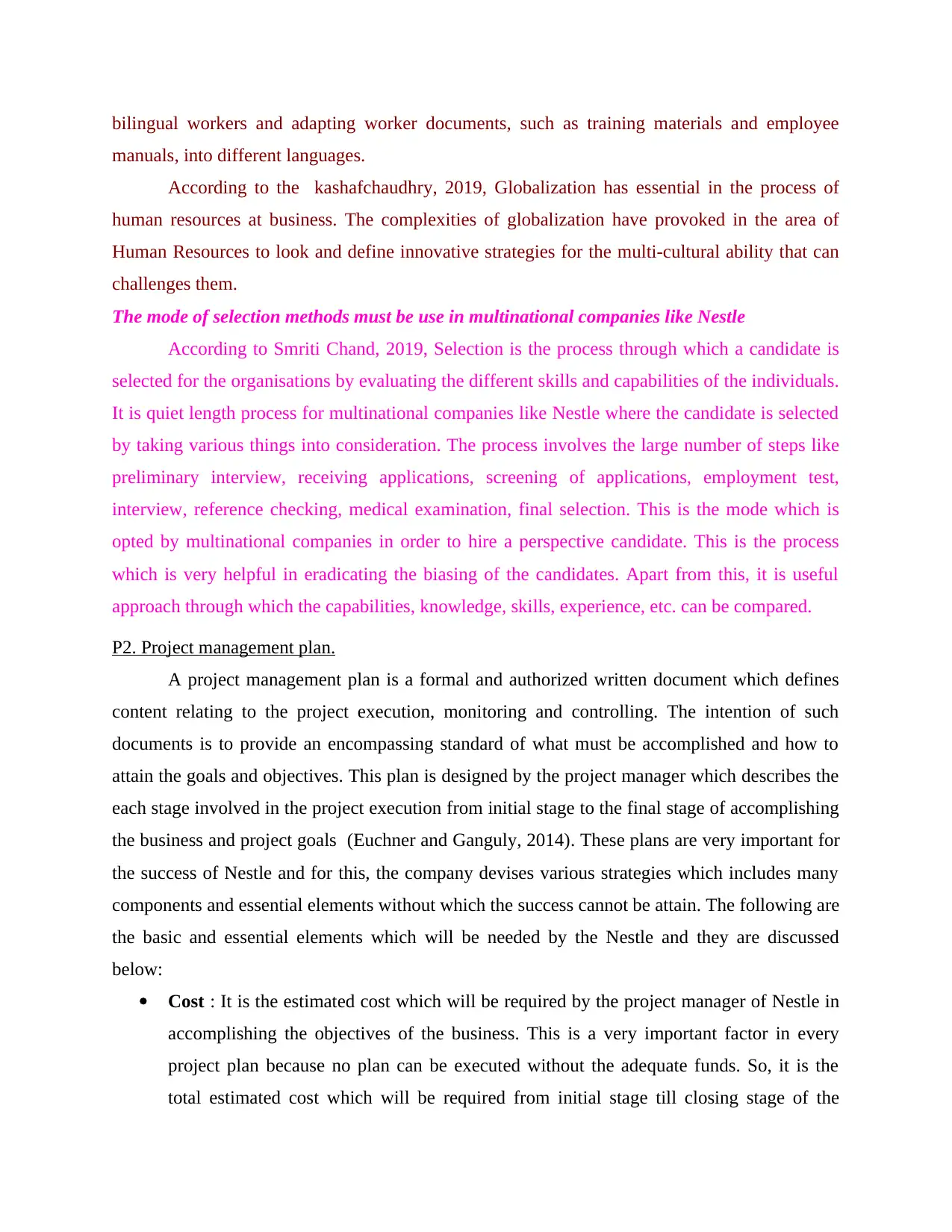
bilingual workers and adapting worker documents, such as training materials and employee
manuals, into different languages.
According to the kashafchaudhry, 2019, Globalization has essential in the process of
human resources at business. The complexities of globalization have provoked in the area of
Human Resources to look and define innovative strategies for the multi-cultural ability that can
challenges them.
The mode of selection methods must be use in multinational companies like Nestle
According to Smriti Chand, 2019, Selection is the process through which a candidate is
selected for the organisations by evaluating the different skills and capabilities of the individuals.
It is quiet length process for multinational companies like Nestle where the candidate is selected
by taking various things into consideration. The process involves the large number of steps like
preliminary interview, receiving applications, screening of applications, employment test,
interview, reference checking, medical examination, final selection. This is the mode which is
opted by multinational companies in order to hire a perspective candidate. This is the process
which is very helpful in eradicating the biasing of the candidates. Apart from this, it is useful
approach through which the capabilities, knowledge, skills, experience, etc. can be compared.
P2. Project management plan.
A project management plan is a formal and authorized written document which defines
content relating to the project execution, monitoring and controlling. The intention of such
documents is to provide an encompassing standard of what must be accomplished and how to
attain the goals and objectives. This plan is designed by the project manager which describes the
each stage involved in the project execution from initial stage to the final stage of accomplishing
the business and project goals (Euchner and Ganguly, 2014). These plans are very important for
the success of Nestle and for this, the company devises various strategies which includes many
components and essential elements without which the success cannot be attain. The following are
the basic and essential elements which will be needed by the Nestle and they are discussed
below:
Cost : It is the estimated cost which will be required by the project manager of Nestle in
accomplishing the objectives of the business. This is a very important factor in every
project plan because no plan can be executed without the adequate funds. So, it is the
total estimated cost which will be required from initial stage till closing stage of the
manuals, into different languages.
According to the kashafchaudhry, 2019, Globalization has essential in the process of
human resources at business. The complexities of globalization have provoked in the area of
Human Resources to look and define innovative strategies for the multi-cultural ability that can
challenges them.
The mode of selection methods must be use in multinational companies like Nestle
According to Smriti Chand, 2019, Selection is the process through which a candidate is
selected for the organisations by evaluating the different skills and capabilities of the individuals.
It is quiet length process for multinational companies like Nestle where the candidate is selected
by taking various things into consideration. The process involves the large number of steps like
preliminary interview, receiving applications, screening of applications, employment test,
interview, reference checking, medical examination, final selection. This is the mode which is
opted by multinational companies in order to hire a perspective candidate. This is the process
which is very helpful in eradicating the biasing of the candidates. Apart from this, it is useful
approach through which the capabilities, knowledge, skills, experience, etc. can be compared.
P2. Project management plan.
A project management plan is a formal and authorized written document which defines
content relating to the project execution, monitoring and controlling. The intention of such
documents is to provide an encompassing standard of what must be accomplished and how to
attain the goals and objectives. This plan is designed by the project manager which describes the
each stage involved in the project execution from initial stage to the final stage of accomplishing
the business and project goals (Euchner and Ganguly, 2014). These plans are very important for
the success of Nestle and for this, the company devises various strategies which includes many
components and essential elements without which the success cannot be attain. The following are
the basic and essential elements which will be needed by the Nestle and they are discussed
below:
Cost : It is the estimated cost which will be required by the project manager of Nestle in
accomplishing the objectives of the business. This is a very important factor in every
project plan because no plan can be executed without the adequate funds. So, it is the
total estimated cost which will be required from initial stage till closing stage of the
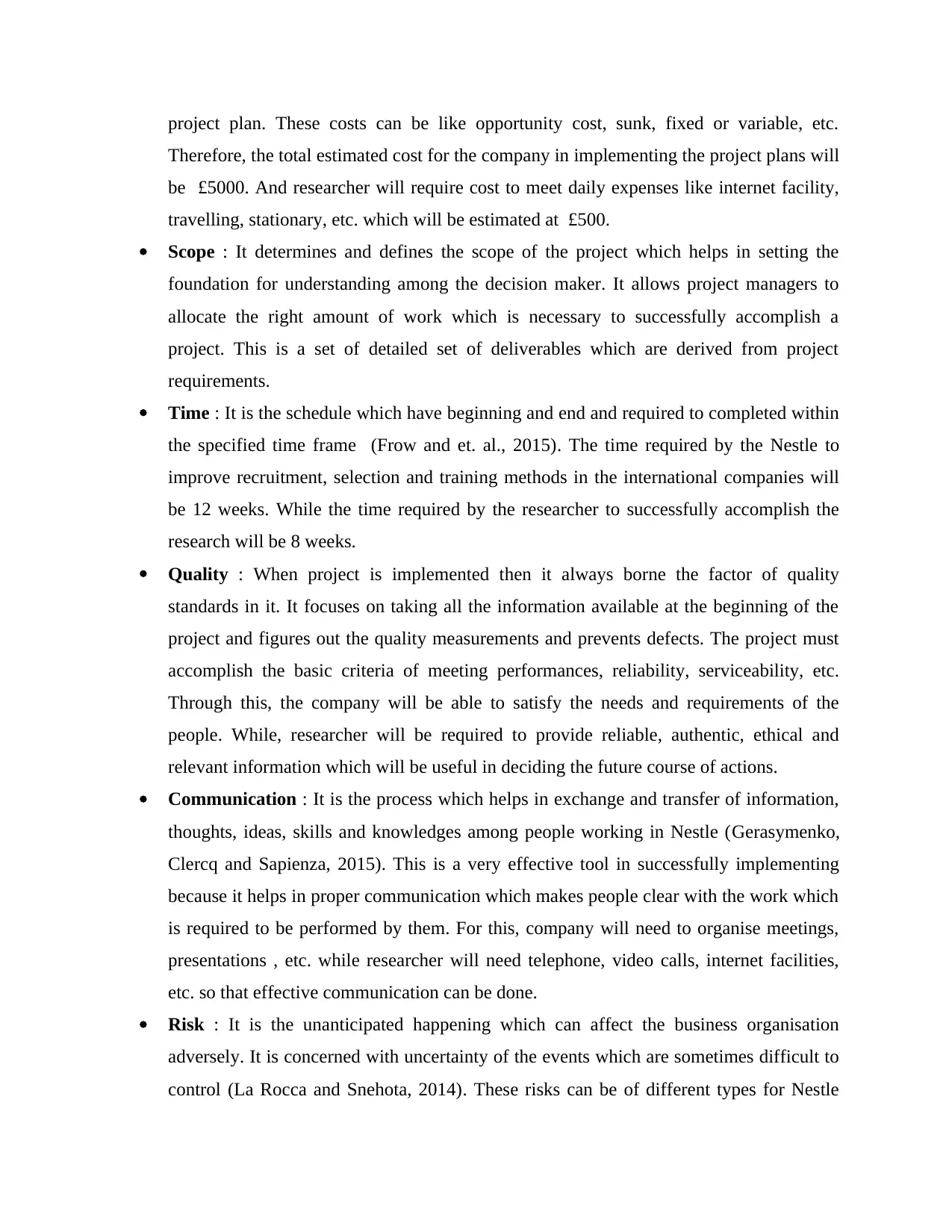
project plan. These costs can be like opportunity cost, sunk, fixed or variable, etc.
Therefore, the total estimated cost for the company in implementing the project plans will
be £5000. And researcher will require cost to meet daily expenses like internet facility,
travelling, stationary, etc. which will be estimated at £500.
Scope : It determines and defines the scope of the project which helps in setting the
foundation for understanding among the decision maker. It allows project managers to
allocate the right amount of work which is necessary to successfully accomplish a
project. This is a set of detailed set of deliverables which are derived from project
requirements.
Time : It is the schedule which have beginning and end and required to completed within
the specified time frame (Frow and et. al., 2015). The time required by the Nestle to
improve recruitment, selection and training methods in the international companies will
be 12 weeks. While the time required by the researcher to successfully accomplish the
research will be 8 weeks.
Quality : When project is implemented then it always borne the factor of quality
standards in it. It focuses on taking all the information available at the beginning of the
project and figures out the quality measurements and prevents defects. The project must
accomplish the basic criteria of meeting performances, reliability, serviceability, etc.
Through this, the company will be able to satisfy the needs and requirements of the
people. While, researcher will be required to provide reliable, authentic, ethical and
relevant information which will be useful in deciding the future course of actions.
Communication : It is the process which helps in exchange and transfer of information,
thoughts, ideas, skills and knowledges among people working in Nestle (Gerasymenko,
Clercq and Sapienza, 2015). This is a very effective tool in successfully implementing
because it helps in proper communication which makes people clear with the work which
is required to be performed by them. For this, company will need to organise meetings,
presentations , etc. while researcher will need telephone, video calls, internet facilities,
etc. so that effective communication can be done.
Risk : It is the unanticipated happening which can affect the business organisation
adversely. It is concerned with uncertainty of the events which are sometimes difficult to
control (La Rocca and Snehota, 2014). These risks can be of different types for Nestle
Therefore, the total estimated cost for the company in implementing the project plans will
be £5000. And researcher will require cost to meet daily expenses like internet facility,
travelling, stationary, etc. which will be estimated at £500.
Scope : It determines and defines the scope of the project which helps in setting the
foundation for understanding among the decision maker. It allows project managers to
allocate the right amount of work which is necessary to successfully accomplish a
project. This is a set of detailed set of deliverables which are derived from project
requirements.
Time : It is the schedule which have beginning and end and required to completed within
the specified time frame (Frow and et. al., 2015). The time required by the Nestle to
improve recruitment, selection and training methods in the international companies will
be 12 weeks. While the time required by the researcher to successfully accomplish the
research will be 8 weeks.
Quality : When project is implemented then it always borne the factor of quality
standards in it. It focuses on taking all the information available at the beginning of the
project and figures out the quality measurements and prevents defects. The project must
accomplish the basic criteria of meeting performances, reliability, serviceability, etc.
Through this, the company will be able to satisfy the needs and requirements of the
people. While, researcher will be required to provide reliable, authentic, ethical and
relevant information which will be useful in deciding the future course of actions.
Communication : It is the process which helps in exchange and transfer of information,
thoughts, ideas, skills and knowledges among people working in Nestle (Gerasymenko,
Clercq and Sapienza, 2015). This is a very effective tool in successfully implementing
because it helps in proper communication which makes people clear with the work which
is required to be performed by them. For this, company will need to organise meetings,
presentations , etc. while researcher will need telephone, video calls, internet facilities,
etc. so that effective communication can be done.
Risk : It is the unanticipated happening which can affect the business organisation
adversely. It is concerned with uncertainty of the events which are sometimes difficult to
control (La Rocca and Snehota, 2014). These risks can be of different types for Nestle
⊘ This is a preview!⊘
Do you want full access?
Subscribe today to unlock all pages.

Trusted by 1+ million students worldwide
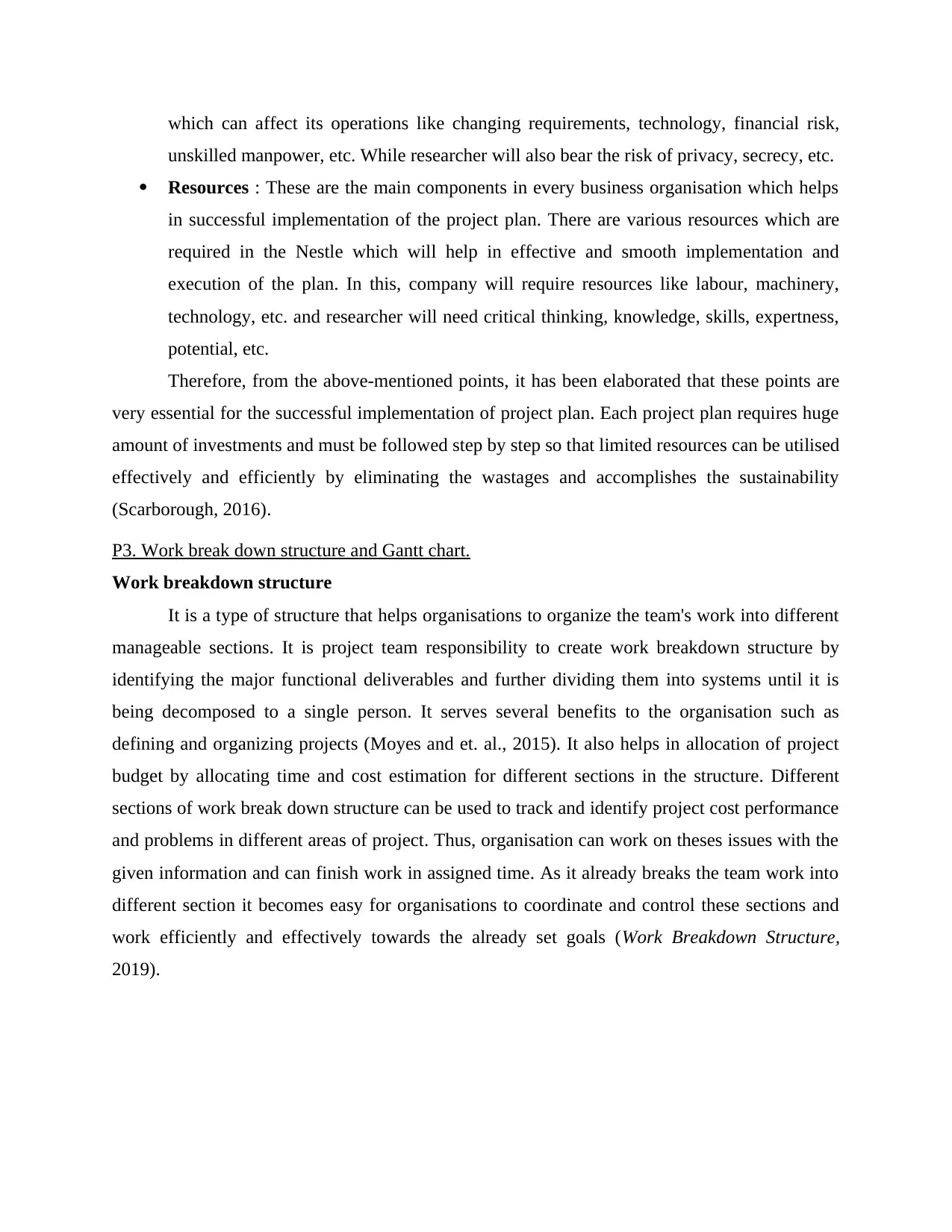
which can affect its operations like changing requirements, technology, financial risk,
unskilled manpower, etc. While researcher will also bear the risk of privacy, secrecy, etc.
Resources : These are the main components in every business organisation which helps
in successful implementation of the project plan. There are various resources which are
required in the Nestle which will help in effective and smooth implementation and
execution of the plan. In this, company will require resources like labour, machinery,
technology, etc. and researcher will need critical thinking, knowledge, skills, expertness,
potential, etc.
Therefore, from the above-mentioned points, it has been elaborated that these points are
very essential for the successful implementation of project plan. Each project plan requires huge
amount of investments and must be followed step by step so that limited resources can be utilised
effectively and efficiently by eliminating the wastages and accomplishes the sustainability
(Scarborough, 2016).
P3. Work break down structure and Gantt chart.
Work breakdown structure
It is a type of structure that helps organisations to organize the team's work into different
manageable sections. It is project team responsibility to create work breakdown structure by
identifying the major functional deliverables and further dividing them into systems until it is
being decomposed to a single person. It serves several benefits to the organisation such as
defining and organizing projects (Moyes and et. al., 2015). It also helps in allocation of project
budget by allocating time and cost estimation for different sections in the structure. Different
sections of work break down structure can be used to track and identify project cost performance
and problems in different areas of project. Thus, organisation can work on theses issues with the
given information and can finish work in assigned time. As it already breaks the team work into
different section it becomes easy for organisations to coordinate and control these sections and
work efficiently and effectively towards the already set goals (Work Breakdown Structure,
2019).
unskilled manpower, etc. While researcher will also bear the risk of privacy, secrecy, etc.
Resources : These are the main components in every business organisation which helps
in successful implementation of the project plan. There are various resources which are
required in the Nestle which will help in effective and smooth implementation and
execution of the plan. In this, company will require resources like labour, machinery,
technology, etc. and researcher will need critical thinking, knowledge, skills, expertness,
potential, etc.
Therefore, from the above-mentioned points, it has been elaborated that these points are
very essential for the successful implementation of project plan. Each project plan requires huge
amount of investments and must be followed step by step so that limited resources can be utilised
effectively and efficiently by eliminating the wastages and accomplishes the sustainability
(Scarborough, 2016).
P3. Work break down structure and Gantt chart.
Work breakdown structure
It is a type of structure that helps organisations to organize the team's work into different
manageable sections. It is project team responsibility to create work breakdown structure by
identifying the major functional deliverables and further dividing them into systems until it is
being decomposed to a single person. It serves several benefits to the organisation such as
defining and organizing projects (Moyes and et. al., 2015). It also helps in allocation of project
budget by allocating time and cost estimation for different sections in the structure. Different
sections of work break down structure can be used to track and identify project cost performance
and problems in different areas of project. Thus, organisation can work on theses issues with the
given information and can finish work in assigned time. As it already breaks the team work into
different section it becomes easy for organisations to coordinate and control these sections and
work efficiently and effectively towards the already set goals (Work Breakdown Structure,
2019).
Paraphrase This Document
Need a fresh take? Get an instant paraphrase of this document with our AI Paraphraser
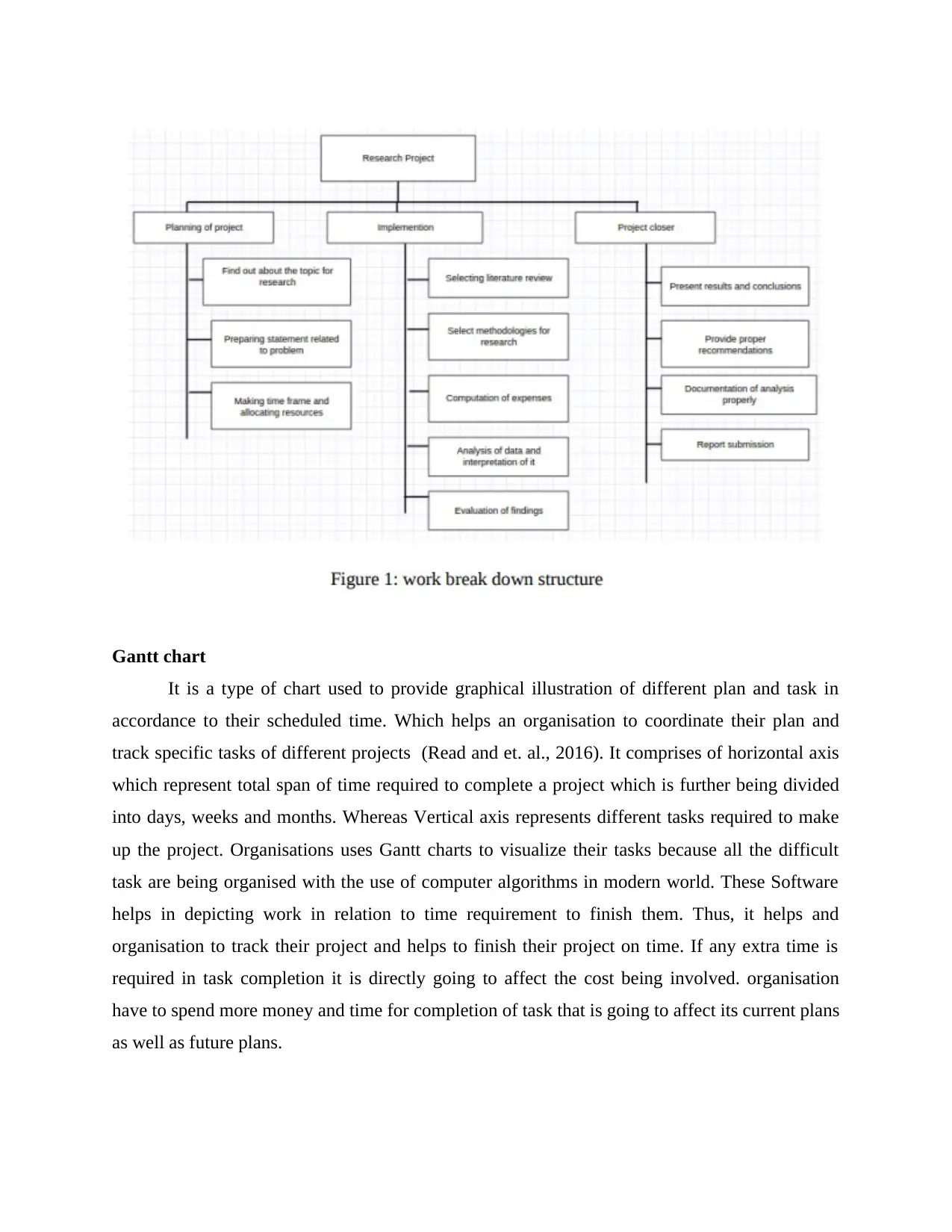
Gantt chart
It is a type of chart used to provide graphical illustration of different plan and task in
accordance to their scheduled time. Which helps an organisation to coordinate their plan and
track specific tasks of different projects (Read and et. al., 2016). It comprises of horizontal axis
which represent total span of time required to complete a project which is further being divided
into days, weeks and months. Whereas Vertical axis represents different tasks required to make
up the project. Organisations uses Gantt charts to visualize their tasks because all the difficult
task are being organised with the use of computer algorithms in modern world. These Software
helps in depicting work in relation to time requirement to finish them. Thus, it helps and
organisation to track their project and helps to finish their project on time. If any extra time is
required in task completion it is directly going to affect the cost being involved. organisation
have to spend more money and time for completion of task that is going to affect its current plans
as well as future plans.
It is a type of chart used to provide graphical illustration of different plan and task in
accordance to their scheduled time. Which helps an organisation to coordinate their plan and
track specific tasks of different projects (Read and et. al., 2016). It comprises of horizontal axis
which represent total span of time required to complete a project which is further being divided
into days, weeks and months. Whereas Vertical axis represents different tasks required to make
up the project. Organisations uses Gantt charts to visualize their tasks because all the difficult
task are being organised with the use of computer algorithms in modern world. These Software
helps in depicting work in relation to time requirement to finish them. Thus, it helps and
organisation to track their project and helps to finish their project on time. If any extra time is
required in task completion it is directly going to affect the cost being involved. organisation
have to spend more money and time for completion of task that is going to affect its current plans
as well as future plans.
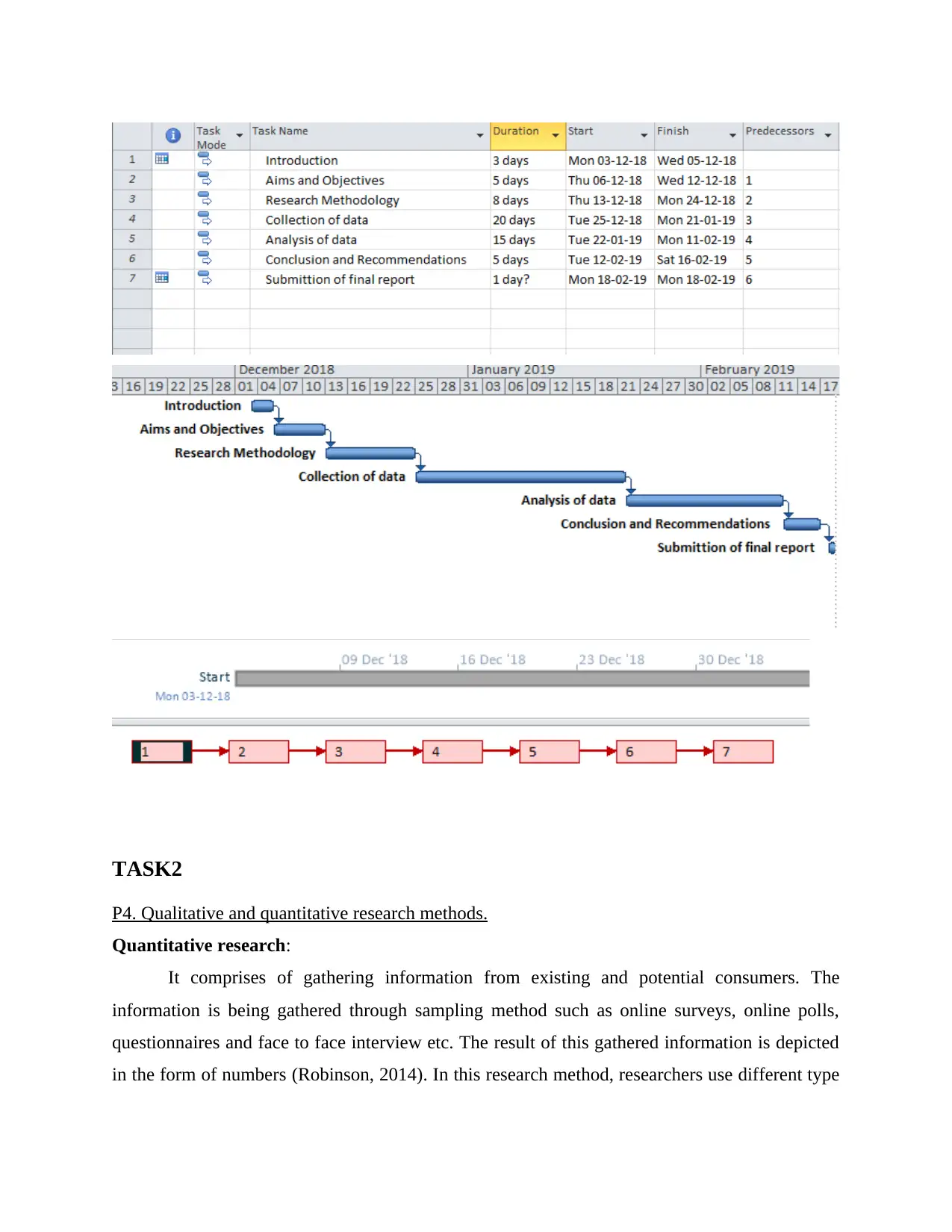
TASK2
P4. Qualitative and quantitative research methods.
Quantitative research:
It comprises of gathering information from existing and potential consumers. The
information is being gathered through sampling method such as online surveys, online polls,
questionnaires and face to face interview etc. The result of this gathered information is depicted
in the form of numbers (Robinson, 2014). In this research method, researchers use different type
P4. Qualitative and quantitative research methods.
Quantitative research:
It comprises of gathering information from existing and potential consumers. The
information is being gathered through sampling method such as online surveys, online polls,
questionnaires and face to face interview etc. The result of this gathered information is depicted
in the form of numbers (Robinson, 2014). In this research method, researchers use different type
⊘ This is a preview!⊘
Do you want full access?
Subscribe today to unlock all pages.

Trusted by 1+ million students worldwide
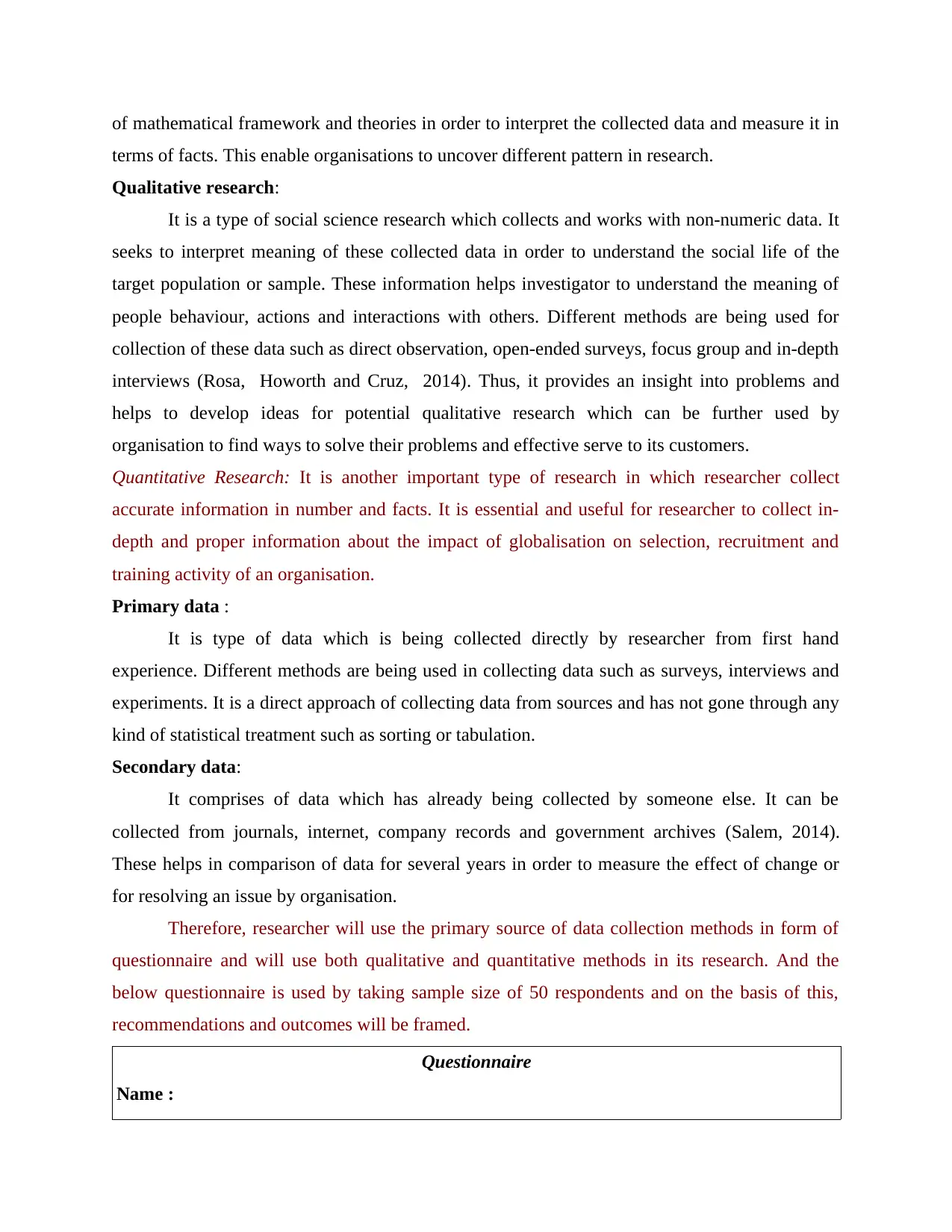
of mathematical framework and theories in order to interpret the collected data and measure it in
terms of facts. This enable organisations to uncover different pattern in research.
Qualitative research:
It is a type of social science research which collects and works with non-numeric data. It
seeks to interpret meaning of these collected data in order to understand the social life of the
target population or sample. These information helps investigator to understand the meaning of
people behaviour, actions and interactions with others. Different methods are being used for
collection of these data such as direct observation, open-ended surveys, focus group and in-depth
interviews (Rosa, Howorth and Cruz, 2014). Thus, it provides an insight into problems and
helps to develop ideas for potential qualitative research which can be further used by
organisation to find ways to solve their problems and effective serve to its customers.
Quantitative Research: It is another important type of research in which researcher collect
accurate information in number and facts. It is essential and useful for researcher to collect in-
depth and proper information about the impact of globalisation on selection, recruitment and
training activity of an organisation.
Primary data :
It is type of data which is being collected directly by researcher from first hand
experience. Different methods are being used in collecting data such as surveys, interviews and
experiments. It is a direct approach of collecting data from sources and has not gone through any
kind of statistical treatment such as sorting or tabulation.
Secondary data:
It comprises of data which has already being collected by someone else. It can be
collected from journals, internet, company records and government archives (Salem, 2014).
These helps in comparison of data for several years in order to measure the effect of change or
for resolving an issue by organisation.
Therefore, researcher will use the primary source of data collection methods in form of
questionnaire and will use both qualitative and quantitative methods in its research. And the
below questionnaire is used by taking sample size of 50 respondents and on the basis of this,
recommendations and outcomes will be framed.
Questionnaire
Name :
terms of facts. This enable organisations to uncover different pattern in research.
Qualitative research:
It is a type of social science research which collects and works with non-numeric data. It
seeks to interpret meaning of these collected data in order to understand the social life of the
target population or sample. These information helps investigator to understand the meaning of
people behaviour, actions and interactions with others. Different methods are being used for
collection of these data such as direct observation, open-ended surveys, focus group and in-depth
interviews (Rosa, Howorth and Cruz, 2014). Thus, it provides an insight into problems and
helps to develop ideas for potential qualitative research which can be further used by
organisation to find ways to solve their problems and effective serve to its customers.
Quantitative Research: It is another important type of research in which researcher collect
accurate information in number and facts. It is essential and useful for researcher to collect in-
depth and proper information about the impact of globalisation on selection, recruitment and
training activity of an organisation.
Primary data :
It is type of data which is being collected directly by researcher from first hand
experience. Different methods are being used in collecting data such as surveys, interviews and
experiments. It is a direct approach of collecting data from sources and has not gone through any
kind of statistical treatment such as sorting or tabulation.
Secondary data:
It comprises of data which has already being collected by someone else. It can be
collected from journals, internet, company records and government archives (Salem, 2014).
These helps in comparison of data for several years in order to measure the effect of change or
for resolving an issue by organisation.
Therefore, researcher will use the primary source of data collection methods in form of
questionnaire and will use both qualitative and quantitative methods in its research. And the
below questionnaire is used by taking sample size of 50 respondents and on the basis of this,
recommendations and outcomes will be framed.
Questionnaire
Name :
Paraphrase This Document
Need a fresh take? Get an instant paraphrase of this document with our AI Paraphraser
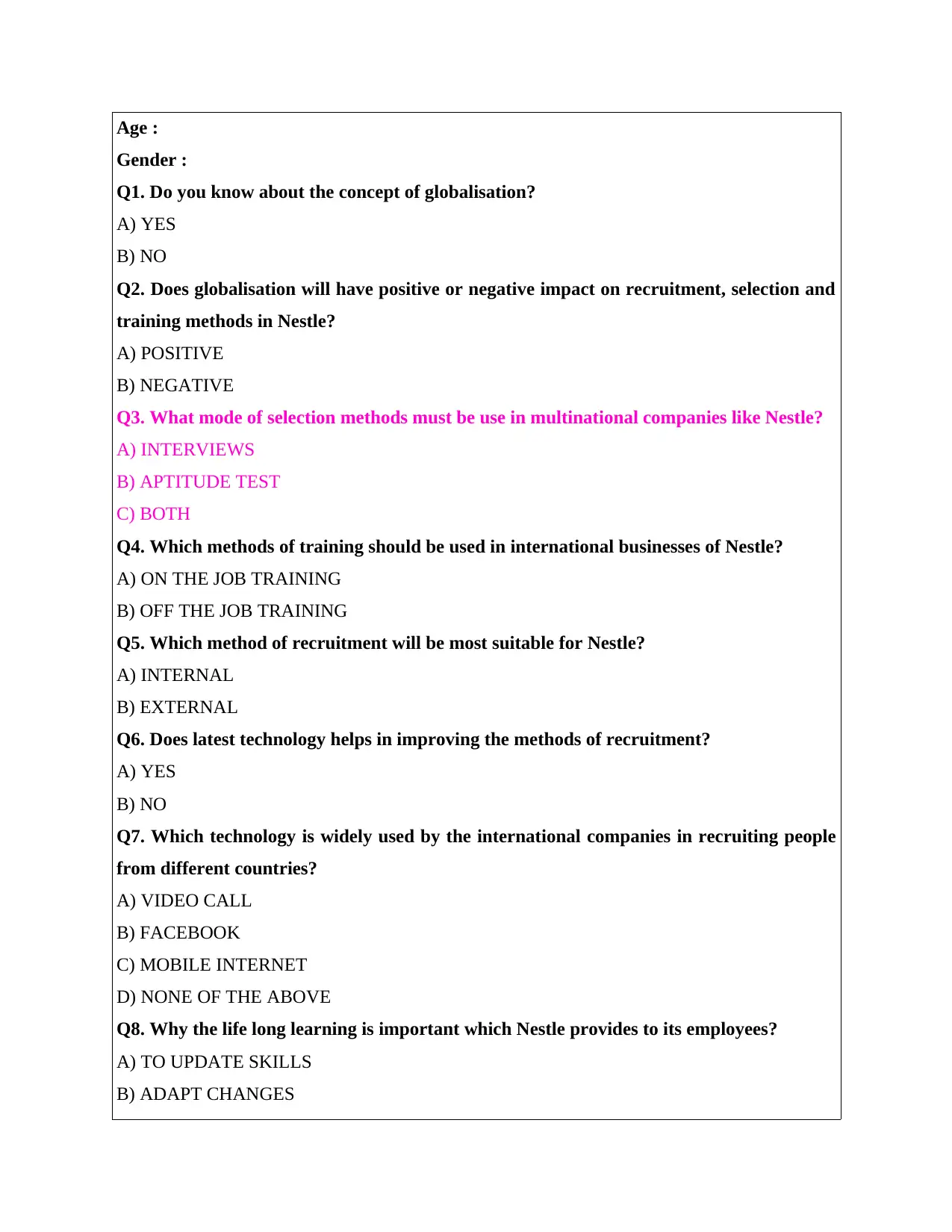
Age :
Gender :
Q1. Do you know about the concept of globalisation?
A) YES
B) NO
Q2. Does globalisation will have positive or negative impact on recruitment, selection and
training methods in Nestle?
A) POSITIVE
B) NEGATIVE
Q3. What mode of selection methods must be use in multinational companies like Nestle?
A) INTERVIEWS
B) APTITUDE TEST
C) BOTH
Q4. Which methods of training should be used in international businesses of Nestle?
A) ON THE JOB TRAINING
B) OFF THE JOB TRAINING
Q5. Which method of recruitment will be most suitable for Nestle?
A) INTERNAL
B) EXTERNAL
Q6. Does latest technology helps in improving the methods of recruitment?
A) YES
B) NO
Q7. Which technology is widely used by the international companies in recruiting people
from different countries?
A) VIDEO CALL
B) FACEBOOK
C) MOBILE INTERNET
D) NONE OF THE ABOVE
Q8. Why the life long learning is important which Nestle provides to its employees?
A) TO UPDATE SKILLS
B) ADAPT CHANGES
Gender :
Q1. Do you know about the concept of globalisation?
A) YES
B) NO
Q2. Does globalisation will have positive or negative impact on recruitment, selection and
training methods in Nestle?
A) POSITIVE
B) NEGATIVE
Q3. What mode of selection methods must be use in multinational companies like Nestle?
A) INTERVIEWS
B) APTITUDE TEST
C) BOTH
Q4. Which methods of training should be used in international businesses of Nestle?
A) ON THE JOB TRAINING
B) OFF THE JOB TRAINING
Q5. Which method of recruitment will be most suitable for Nestle?
A) INTERNAL
B) EXTERNAL
Q6. Does latest technology helps in improving the methods of recruitment?
A) YES
B) NO
Q7. Which technology is widely used by the international companies in recruiting people
from different countries?
A) VIDEO CALL
B) FACEBOOK
C) MOBILE INTERNET
D) NONE OF THE ABOVE
Q8. Why the life long learning is important which Nestle provides to its employees?
A) TO UPDATE SKILLS
B) ADAPT CHANGES
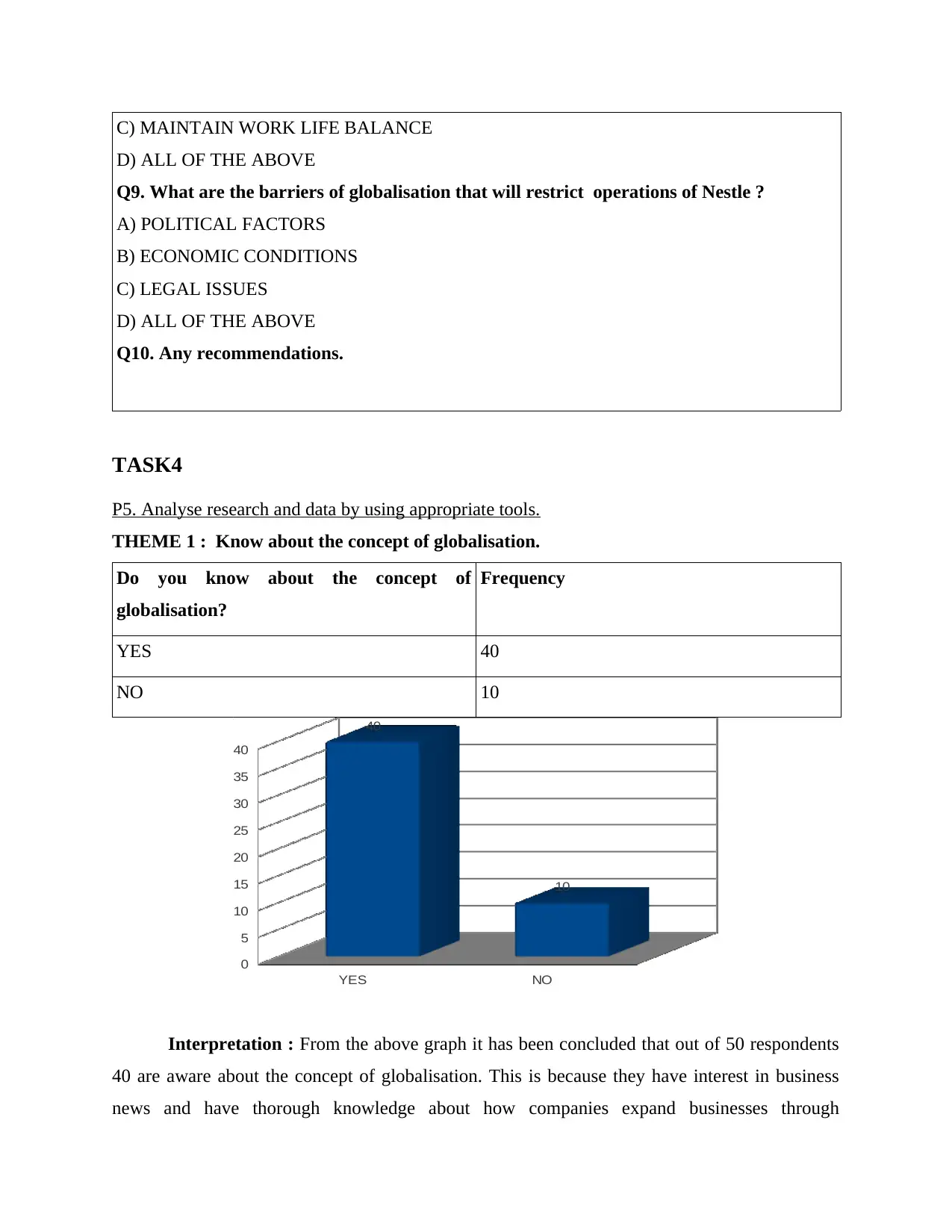
C) MAINTAIN WORK LIFE BALANCE
D) ALL OF THE ABOVE
Q9. What are the barriers of globalisation that will restrict operations of Nestle ?
A) POLITICAL FACTORS
B) ECONOMIC CONDITIONS
C) LEGAL ISSUES
D) ALL OF THE ABOVE
Q10. Any recommendations.
TASK4
P5. Analyse research and data by using appropriate tools.
THEME 1 : Know about the concept of globalisation.
Do you know about the concept of
globalisation?
Frequency
YES 40
NO 10
Interpretation : From the above graph it has been concluded that out of 50 respondents
40 are aware about the concept of globalisation. This is because they have interest in business
news and have thorough knowledge about how companies expand businesses through
YES NO
0
5
10
15
20
25
30
35
40
40
10
D) ALL OF THE ABOVE
Q9. What are the barriers of globalisation that will restrict operations of Nestle ?
A) POLITICAL FACTORS
B) ECONOMIC CONDITIONS
C) LEGAL ISSUES
D) ALL OF THE ABOVE
Q10. Any recommendations.
TASK4
P5. Analyse research and data by using appropriate tools.
THEME 1 : Know about the concept of globalisation.
Do you know about the concept of
globalisation?
Frequency
YES 40
NO 10
Interpretation : From the above graph it has been concluded that out of 50 respondents
40 are aware about the concept of globalisation. This is because they have interest in business
news and have thorough knowledge about how companies expand businesses through
YES NO
0
5
10
15
20
25
30
35
40
40
10
⊘ This is a preview!⊘
Do you want full access?
Subscribe today to unlock all pages.

Trusted by 1+ million students worldwide
1 out of 29
Related Documents
Your All-in-One AI-Powered Toolkit for Academic Success.
+13062052269
info@desklib.com
Available 24*7 on WhatsApp / Email
![[object Object]](/_next/static/media/star-bottom.7253800d.svg)
Unlock your academic potential
Copyright © 2020–2025 A2Z Services. All Rights Reserved. Developed and managed by ZUCOL.





